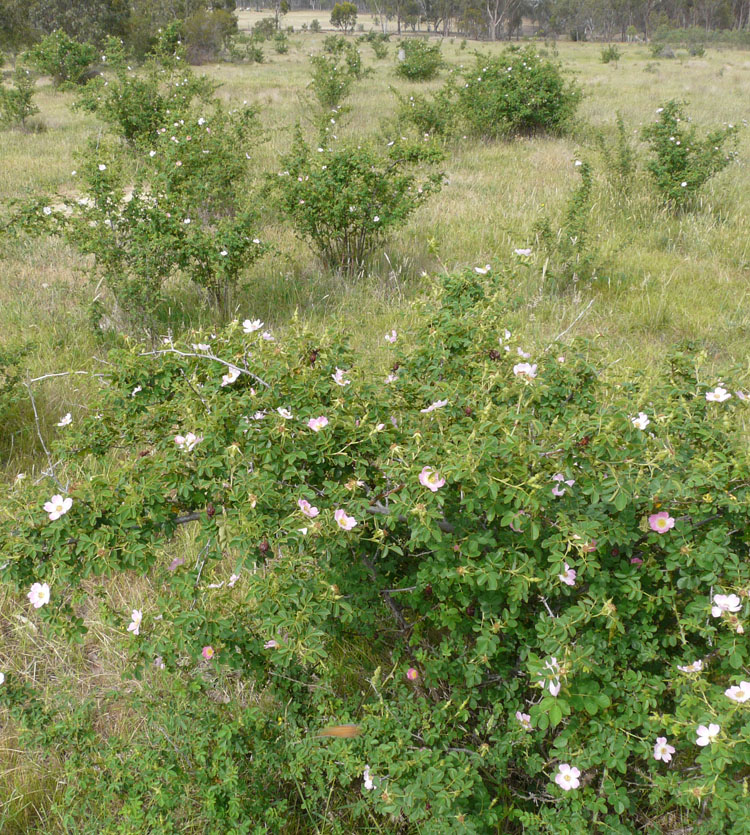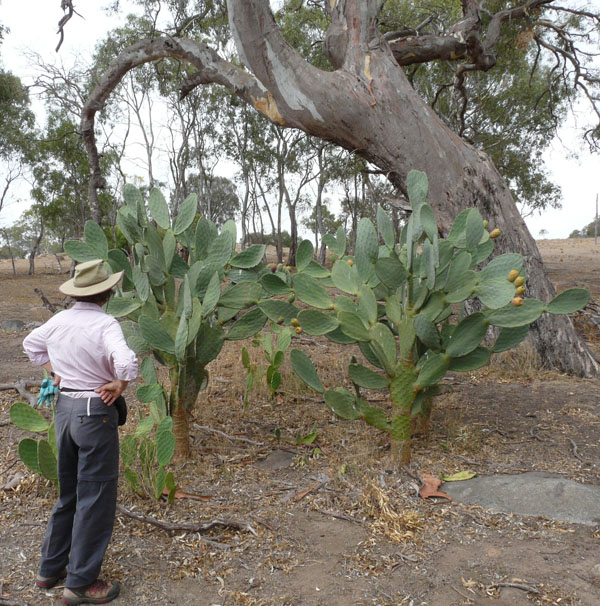
There are at least 203 plant species in the park which would not have been there prior to the arrival of Europeans. Most of these are considered to be weeds in most areas of the park. Whether a plant is considered a weed or not often depends on it's location. For example an introduced pasture grass in one of the fenced paddocks around the homestead is not considered a weed. However in one of the more natural areas of the park it would be.
The count of weed species does not include plants in the homestead garden, but does include species planted as garden plants around Dundonald and Cumberland homesteads. Although the management plan does not have anything to say about these some of them have historic interest, such as the Stone Pine on Gellibrand Hill. However their offspring (if any) must be considered weeds, and management needs to accept that retention of historic plants brings an ongoing obligation for preventing their spread. The most problematic species in this respect is probably Sugar Gum. Now that the Sugar Gums in the plantation and elsewhere are mature, saplings continually spring up around them. The problem is worst on the south side of the plantation and in Weeroona Cemetery conservation zone.
Australian plants can be weeds in the park if they are outside of their natural range. Examples are Sugar Gum, native to South Australia, Mahogany Gum, Cootamundra Wattle and Early Black Wattle from NSW, and Sweet Pittosporum from Eastern Victoria.
Not all weeds are of equal significance. Whether to target a particular species for control should be decided based on its impact on local species (both plants and animals), its potential impact if no action is taken, and whether any control is feasible. The urgency of action depends on the rate of spread and proximity to vegetation worthy of protection. It should also consider the cost of eradicating small infestations early as opposed to waiting until they get bigger and costlier to control.
Another possible consideration in deciding priorities is whether the weed is a declared weed under the Catchment and Land Protection Act - what used to be called noxious weeds. Private landholders are required to control such weeds so Parks Victoria should do the same in order to be a good neighbour, even though the act has never been applied to the government itself. This is not as important a consideration as it used to be since the act is no longer enforced - it's every farmer for them self nowadays.
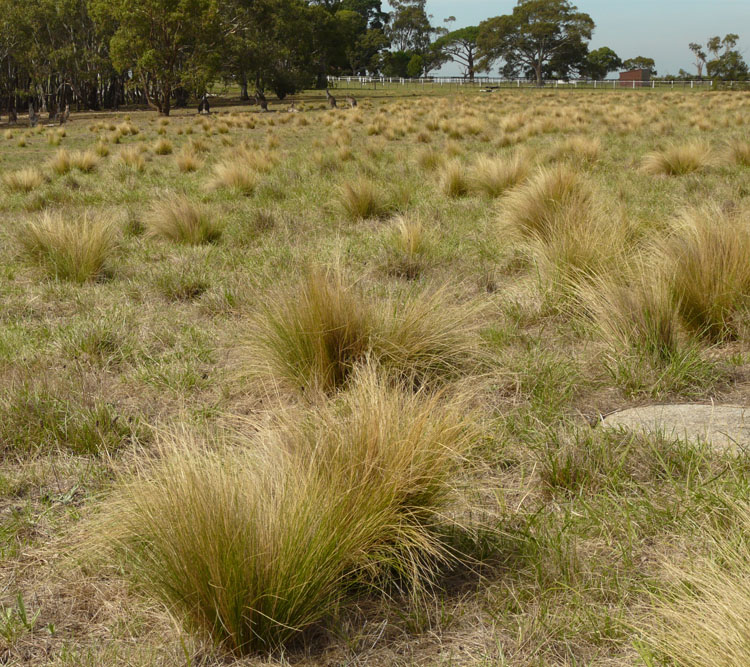
The 1997 Management Plan (the latest available) lists the following species which are to be controlled:
- Gorse
- African Box-thorn
- Sweet Briar
- Serrated Tussock
- Chilean Needle Grass
- One-leaf Cape Tulip
- Paterson's Curse
- Toowoomba Canary-grass (Phalaris)
- Artichoke Thistle
- St Johns Wort
As well as the above list, the management plan contains the following as a strategy:
Implement the strategies for integrated pest plant and animal control as outlined in the Restoration Plan (Carr et al. 1996).
The Restoration Plan recommended the preparation of a weed management plan, and this was done (Mueck & Walters 1996), but it was presumably not accepted since the management plan cites the former and not the latter. Weed management (as opposed to weed control) issues include avoiding actions that spread weeds or encourage their spread, and avoiding or reversing conditions that favour weed invasion, such as soil compaction and high nutrient levels. It also includes re-vegetation, since this is the only way to eliminate weeds from areas where they are the only vegetation. A weed management plan should also take into account the need to provide alternative habitat before removing large areas of weeds that are utilized by wildlife.
The Weed Management plan does not address all these issues but it does go further than the Restoration Plan. It contains some pertinent information on fire regimes, for example a comment from the then Ranger in Charge Mike Cusack that repeated fuel reduction burns had resulted in a change of the dominant grass in the north-western corner of the park from Phalaris to Chilean Needle Grass (p. 36) - both of them weeds of course!. It recommends that areas of Chilean Needle Grass be burnt at the right time to destroy most seed (i.e. early summer), while areas of native grass be burnt after seed has dropped (late summer or autumn). In practice all burns at Woodlands Historic Park are done in autumn. While weed control professionals working for councils or on private land generally burn native grasslands in Spring, state government authorities are unable to do this for one reason or another.
There is half a page in the plan about monitoring, including the following:
Proper monitoring of all the pest plants ... is considered to be beyond the park resources committed to pest plant control works.
This was in 1996 when staffing levels were much higher than they are today.
The Restoration Plan contains a table of 36 weed species prioritised for control on a scale of 1 to 3. (The Weed Management Plan contains a similar list based on the one in the Restoration Plan.) I have extracted the priority 1 weeds from this table, and upgraded a few (Paterson's Curse, which was listed in the management plan, plus Kikuyu and Sugar Gum). I have also added some species which the restoration plan overlooked or which were not present at the time. This includes species which are a problem on the former Greenvale Sanatorium land, which was not part of the park when the Restoration Plan was written. It also includes St Johns Wort - despite not being listed in the Restoration Plan it must have already existed in the park since it was mentioned in the Management Plan and the Weed Management Plan.
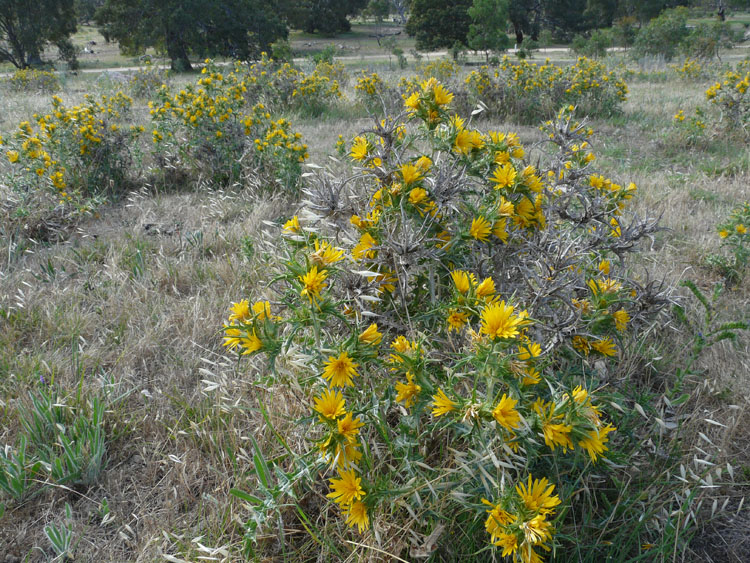
Plants often have multiple species of insects and fungi that feed exclusively on that plant species. One reason plants from other countries can often out-compete local plants is that the pests got left behind when the plant was brought to Australia (this is known as the enemy release hypothesis). If these pests can be identified and proven to be host specific then they can be released in Australia and provide Biological control. Unfortunately most weeds must be controlled by more expensive means.
The Kennett state government decreed that jobs such as weed control should be done by by contractors rather than government employees, and reduced Parks Victoria staff as a result. Ever since then there has been a more or less continuous real decrease in the Parks Victoria budget, including the budget for weed control contractors, to the point where in the 2015/2016 financial year there is a nil recurring budget allocation for weed control statewide. There are however small amounts of weed funding for "amenities" and in connection with prescribed burns. It was also pleasing to see Parks Victoria staff doing some weed control themselves in 2015, which is the first time this has happened at Woodlands Historic Park since the Kennett era. However Parks Victoria does not have suitable equipment for spraying weeds such as Patterson's Curse which occur over large areas.
Changes in Weed Distribution and Abundance Over Time
The only comprehensive flora survey of the park was done by Robertson in 1981, who surveyed 264 quadrats on a 100 by 200m grid. There has been no such survey of the areas added to the park since that time.
The high priority herbaceous weeds Chilean Needle Grass, Serrated Tussock, Paterson's Curse and Cape Tulip were all listed by Robinson as occurring in the park. I don't have access to the original quadrat data, but in Robinson's summary (table 3.6) he does not mention any of these four weeds as being significant in any group of quadrats. On page 271 he reports that "Serrated Tussock is not common in the park" and that "it is eradicated wherever found".
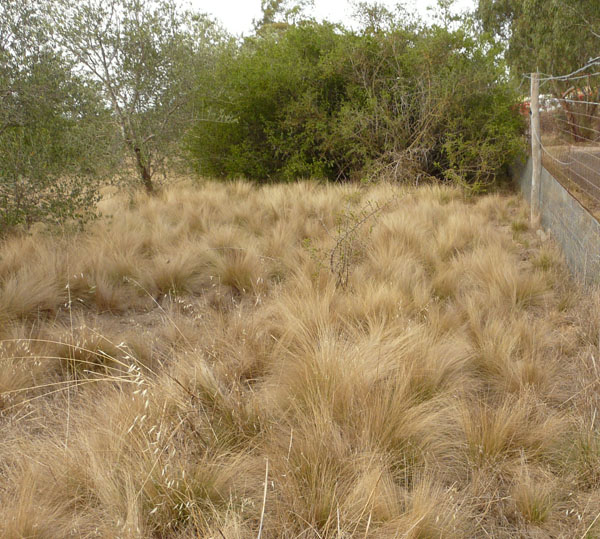
By 1997 when the management plan was written Cape Tulip was listed as common and the other three species as abundant and widespread. All have continued to spread since then. There has never been any significant attempt to control Chilean Needle Grass, while control of Serrated Tussock has been increasingly sporadic and clearly insufficient to counter the continual influx of windblown seed from neglected public and private land to the south of the park. Attempts to control Cape Tulip and Paterson's Curse were abandoned some years ago.
Robinson's summarized quadrat data does not give much information about the distribution of woody species. However on page 67 he states:
Thickets (of Boxthorn) existed under most of the mature trees in the park in the 1970's but extensive control measures have been undertaken by.the Victorian National Parks Service since then. (In October 1983) extensive thickets only remained in limited areas of "Factor's Land".
Boxthorn was listed in the 1997 management plan as common and was probably at similar levels until recent work by Conservation Volunteers Australia in the Back Paddock and a Green Army team in the western part of the park in 2016. It grows slowly and many of the plants recently controlled were still small. There are however still some very large plants on on the west side of Gellibrand Hill, some of which have regrown from old stumps, and in Twin Dams Paddock. Other woody weeds like Sweet Briar and Apple of Sodom were I believe also extensively controlled in the early years but have regenerated since.
In summary, most of the the weeds on the priority list are currently increasing, except those species controlled by Conservation Volunteers Australia (in the Back Paddock), Friends of Woodlands Historic Park (some areas outside the Back Paddock), or Melbourne Water who control most of the high priority weed species along Moonee Ponds Creek. With it's reduced funding, Parks Victoria is only able to have a positive impact on a few small areas.
